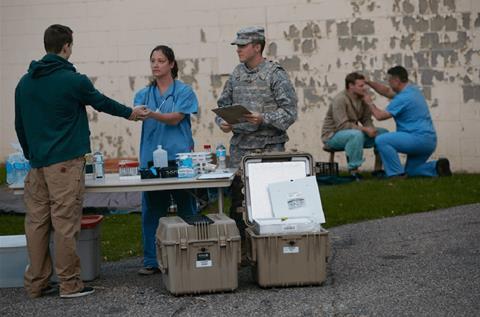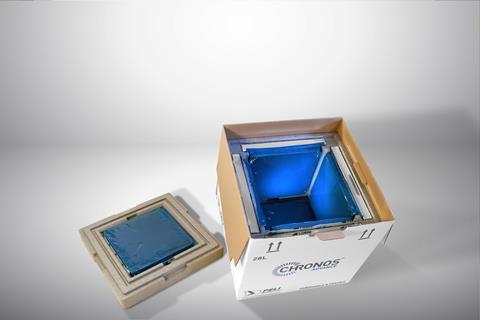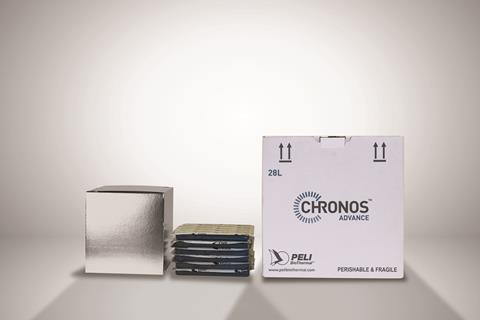
Adam Tetz, Director of Worldwide Marketing for Peli BioThermal, shares with Packaging Europe how innovation and new technologies are proving paramount to the emergence and evolution of smart temperature controlled packaging protecting pharmaceutical payloads worldwide.
Increasingly packaging companies are incorporating innovative design features and utilising more advanced technologies, to produce and manage pioneering products and ever more sophisticated systems, which help eliminate excursions in temperature in cold chain.
As temperature sensitive pharmaceutical products are increasingly being shipped globally to more remote regions there is an even greater demand for innovative solutions being placed on the temperature control packaging industry.
An impetus for the latest generation of high-performing packaging products comes as the pharma industry continues to grow at a significant rate with an estimated global worth of $400 billion by 2020 according to the World Heath Organization.
A driver for a substantial proportion of this projected growth in the life sciences sector includes the rise in temperature-controlled biosimilars and biologics, which are biologically-based pharmaceuticals as opposed to chemical-based. It is predicted more than 50 per cent of approved new drugs are going to be biologics or biosimilars in the next few years.
The evolution of this latest drug development presents its own supply chain challenges when it comes to safe storage and transportation of these temperature and time sensitive pharma products.
More global clinical trials are requiring stricter temperature regulations, which command compliant cold chain conditions and increasingly innovative packaging solutions.
Temperature restrictions when transporting these pharma payloads present their own challenges coupled with the fact more are being shipped to emerging markets where there are also extreme temperature ranges to contend with.
An impetus for the latest generation of high-performing packaging products are these advancements in drug developments, which includes the increase in more fragile and temperature sensitive pharmaceutical products.
Various pharmaceutical compounds, utilised within the sector, are developed under certain temperature control conditions or designed to be stored at specific temperatures to maintain their stability.
Therefore it is vital, when shipping pharmaceutical products between locations, they remain at their storage condition temperatures to maintain their effectiveness at the point of use. Within the industry there are standard temperature ranges such as deep-frozen (below -50° Celsius), frozen (-50° C to -20° C), refrigerated (4° C to 8° C) and room-temperature (15° C to 25° C). With the pharmaceutical companies developing ever more complex and temperature sensitive drugs, there is a greater demand in the cold chain industry to meet the growing market demand for supply as well as improved packaging performance and efficiency. To help mitigate supply chain risks the industry is seeing a greater demand for higher performing packaging products.
Coupled with the rise in regulatory requirements, there is an even greater emphasis on supplying the global market with more advanced, smart packaging that does more than act as a container for precious, high value payloads being transported to emerging markets via complex shipping lanes.
The expertise of experienced engineers is a vital component within the packaging industry with providers deploying increasingly high performing packaging systems that need to mitigate supply chain risks and minimise temperature excursions.
Any spikes or deviations in temperature, beyond the range specific pharmaceutical products are required to be stored and shipped at, could have a devastatingly detrimental effect on the payload, damaging the container’s contents and impacting on the efficacy of the products being transported.
This could have financial repercussions equating to losses of hundreds of thousands of Euros, however more importantly it could have catastrophic consequences for the end user/patients reliant on the drugs being delivered remaining intact.
Whether shipping finished products, transporting clinical trials materials or delivering sample drugs, temperature excursions can mean the difference between success and failure, profit and loss.
It is essential therefore, that pharmaceuticals are protected throughout the supply chain end-to-end as temperature excursions during transportation can even cause them to become toxic. There is increasing recognition within the supply chain of the vital role smart packaging plays and in response to the stringent regulatory requirements the packaging industry is taking a proactive approach.

There is an increase in the introduction of information-centric capabilities to assist with the safe shipping of pharmaceuticals around the globe. Packaging companies are increasingly utilising advanced asset management software systems, which are in place specifically to ensure pharmaceuticals are shipped to the right location, at the right time and critically, that they arrive in the right condition.
Companies deploying pharmaceutical shipments worldwide benefit from the introduction of new technological advancements including web-based asset management software solutions, designed to track individual shipments globally. Integrating these Cloud-based systems, offers a range of capabilities benefiting the industry including options to set up automatic maintenance, next shipments alerts and produce customisable reports.
Some of the latest innovations in smart packaging, serving the life sciences and pharmaceutical industries, are critical developments as ultimately the quality of pharmaceutical products being transported has a direct effect on patient safety and the efficacy of patient therapies.
The industry is also seeing a growing trend to deploy reusable systems coupled with asset management SaaS (software as a service) and reaping the associated benefits. These systems can automatically collect and analyse data from company data logger outputs. Currently operating in the market is a range of SaaS products providing collection and analysis of brand-agnostic sensor data, as it’s linked to a variety of smart packaging options allowing packaging vendors to track a diversity of data including vibration, light, humidity, temperature and more.
These software platforms capture and monitor information throughout the course of the shipments trip. The data retrieved and shared can help pharmaceutical companies make more informed choices on the most appropriate packaging systems to deploy, depending on the specific shipping lanes and routes their payload will navigate.
At Peli BioThermal we utilise our comprehensive asset management software – Crēdo ProEnvision™ - and global service centre solutions to help customers manage the entire life cycle of their shipping inventory of Crēdo™ temperature controlled packaging. These technologies and services help life science industry clients reduce payload risk, distribution costs and their environmental impact ensuring temperature sensitive, critical and high value payloads reach their destination safely.
Integrating the Cloud-based system supports and enhances engineering expertise that is incorporated into the development and design of the increasingly sophisticated systems utilised by the life science industries. Increasingly passive and active bulk systems are incorporating data loggers to track the temperature throughout the course of the trip.
Issues can arise because often a parcel shipment will need to be opened to access the temperature logger stored inside.Alternatively data logger devices can be attached to a specialised container to ship a pallet of products providing an isolated monitoring option to pick up data, which can be saved to the Cloud via Bluetooth or Radio-Frequency Identification (RFID).
Currently operating in the market is a range of SaaS products providing collection and analysis of brand-agnostic sensor data, as its linked to a variety of smart packaging options allowing packaging vendors to track a diversity of data including vibration, light, humidity and more.These software platforms can capture and monitor information throughout the course of the shipments trip.
The latest development within the packaging industry transporting pharma shipments globally is the move toward GPS tracking, which would need to be managed via Bluetooth, RFID or manually-scanned barcodes whereby pharma companies can track packages, and their shipment progress, online.
GPS is the latest development in response to ensuring the protection of high value pharma payloads. It is predicted advancements in GPS tracking options via a SaaS system will be part of the industry in the near future. There are benefits to pharma companies including knowing where their shipment is throughout its transportation trip.
If payloads are lost or get delayed en-route the pharma company take steps to intervene and recharge or replace coolants so the package or the bulk system gets delivered before expected temperature duration is exhausted and this would help mitigate a temperature excursion caused by a delay.
What’s currently not in place in the temperature controlled space for smart packaging is the capabilities to have data logger sensors and SaaS platforms communicate directly with each other, which is on the horizon.
The latest developments will be something that interests the pharmaceutical companies; the availability of information through a SaaS platform will be a market differentiator for the companies that produce this type of smart packaging option. Currently the information being captured is primarily via barcode, which requires human intervention to manually collect and then input the information into a SaaS system.
It’s predicted there will be a move to a system whereby the relevant information will be captured and then stored in a centralised database. That information could be updated frequently at check-in points or instantly via Bluetooth.
Or forensically these smart packaging systems would offer insight to find out at what point the systems failed and where that happened with a combination of GPS and temperature data. This would allow pharma companies to discover when and where a failure occurred and then diagnose if it’s a problem with the shipment, with logistics, with the local customs office or similar.
On the horizon is the integration of GPS and temperature logging to a SaaS system in an effortless way that doesn’t involve human interaction to leverage the movement towards an Internet of Things, which allows products and systems to have an IP address, to be able to interact with the Internet.
Leveraging a movement to an Internet of Things (IoT) will help packaging manufacturers with making future packaging truly smart alongside providing information on the shipment’s status back to its owner in a central office.
It also allows for mid transit interventions if needed or examining efficiencies of scale identified such as using different shipping lanes or different ways to palletise or bulk ship smaller products.
Specialised software systems can also aid reverse logistics within the industry and can provide real-time tracking and trading through the entire end-to-end distribution cycle.
These optimisation tools can help ensure payload efficacy and efficient life cycling of reusable packaging inventory assets providing a high return on investment. Often easy-to-learn and use, these superior software systems helps the global life sciences industry manage its demanding and expanding cold chain logistics supply chain operations while critically meeting the stringent requirements of a highly regulated industry.
There are various technologies currently available offering the advantages of duration and temperature stability.
Traditionally packaging vendors relied on more basic thermal control methods providing passive packaging products where the key forms of technologies deployed were ones incorporating insulating material for the outer box of polystyrene or foams, providing protection and insulation.
To maintain the temperature within the packaging combinations of chilled and frozen water were utilised.
Because of the requirement to carry a lot of water and often bulky insulation, these systems sometimes proved heavy and their performance against highly variable external temperature challenges was not always completely reliable.
Although robust to an extent, these antiquated systems are being replaced more regularly with more technologically advanced packaging systems being developed to meet the demand and regulatory requirements that pharmaceutical companies and the supply chain service providers need to adhere to.

Most recently the technological advancements introduced to the market has seen the advent of better insulation option by incorporating vacuum insulated panels (VIPs) whereby reducing the thickness of the insulation required and improving performance.
The traditional water-based systems are rapidly being replaced with ones using phase change materials (PCMs) where, via a combination of materials, the melting point of the coolants deployed is designed to the ideal temperature required.
These latest advancements mean systems using PCMs are far more reliable providing more stability within the packaging at the desired temperature and using less overall material.
The payload efficiency of these newer systems can be more than twice that of the traditional water based and foam insulated shippers proving more cost effective when it comes to logistics services. Although these more sophisticated shippers can be more expensive the trade off is you are less likely to experience temperature excursions en route, which would lead to damaged products providing a costly consequence in the long run.
In line with the increase in more complex shipping lanes and limited infrastructure in place in some developing destinations, the need for smarter more secure, robust packaging has become more prevalent.
The more sophisticated a shipper the more the unit cost can be so increasingly there is a requirement for reusable systems to provide better return on investment and are more cost effective in the long run alongside the environmental benefits these reusable systems represent.
Provided the infrastructure is in place to recapture and reuse higher performing systems, that contain higher value components, reuse makes economical and environmental sense.
The rise in reuse has trigged a corresponding increase in the global network of service centres being established to facilitate the reconditioning and repurposing of these smarter packaging options.
It has also sparked the rise in SaaS systems within the packaging industry with Cloud capabilities that better enable collaboration in the sometimes complex packaging supply chain and the ability to centralise data focuses the management of packaging services intelligently.
Ultimately the aim always is to continue to reduce the supply chain costs and improve performance and reliability.
More info:











